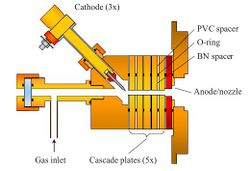Physics:Cascaded arc plasma source
The cascaded arc is a wall-stabilized thermal electric arc discharge that produces a high density, low temperature plasma.
General
The cascaded arc source, developed at the Eindhoven University of Technology,[1][2] is shown in the figure below. Compared to plasma sources in other linear plasma generators, this source can produce high-density argon and hydrogen plasmas (respectively 1021 – 1024 and 1019 – 1022 m−3) at a relatively low electron temperature (~1 eV). Due to the high collision frequency of the particles in the source, the plasma is in thermal equilibrium and reasonably homogeneous.
The cascaded arc consists of a gas inlet, three tungsten cathodes, cascaded plates, a nozzle and an anode. Via the gas inlet, the working gas -argon or hydrogen- can flow into the cathode chamber. The source is typically running at 0.5–3.0 slm (2.2×1020 – 1.3×1020 particles per second) and a discharge current of 100–300 A. The cascaded plates in between the cathode and anode are electrically insulated from each other by 1 mm thick Boron nitride plates. The voltage of these plates is the floating potential. Both nozzle and anode are grounded.
See also
- plasma source
- Plasma window
External links
- A Glow Discharge Unit
- HIGH BRIGHTNESS H- SURFACE PLASMA SOURCES
- H- production in pure hydrogen discharges of surface-plasma sources
References
 |


